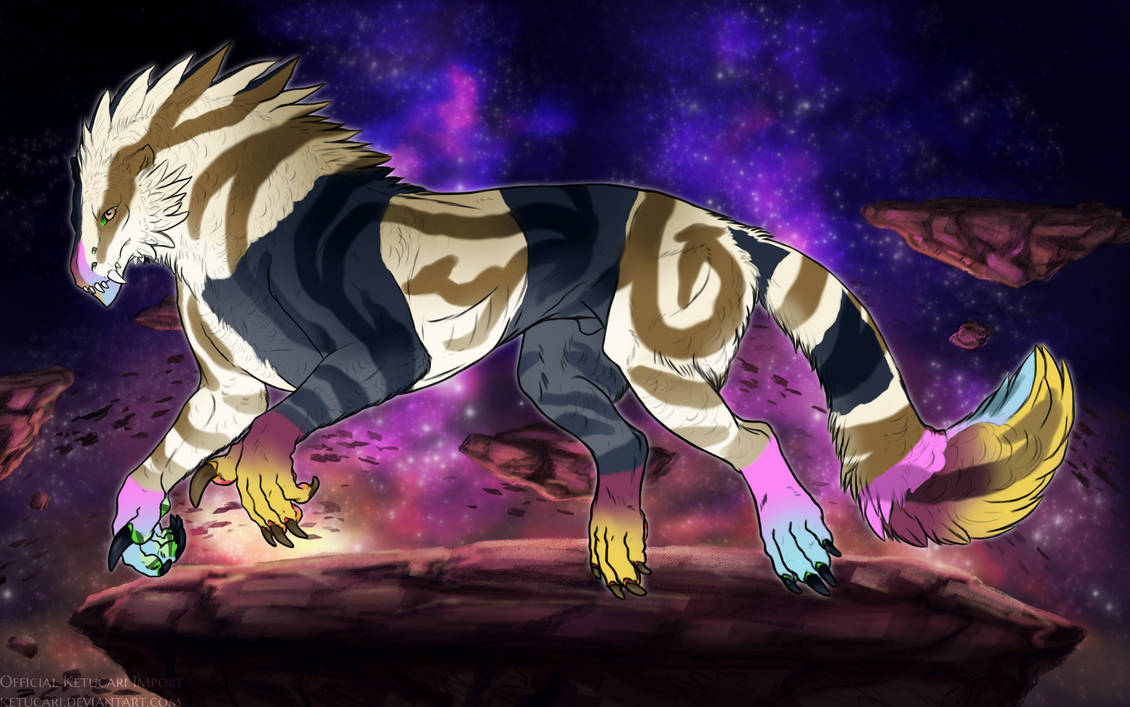Chimera
Examples

Basics
- The chimera gene causes the parents' base colors to show up on the same cub, regardless of the genotype. For example, if you cross a charcoal and a blue ketucari and the cub has the chimera gene, you can use both charcoal and blue bases on the same cub.
- In your ketucari's genotype, chimera is denoted by the letters "nCma" (heterozygous) or "CmaCma" (homozygous).
- In its heterozygous form, chimera has a pass rate of 7%. Homozygous chimera has a 32% pass rate.
Color and Shape
You can only use two colors for chimera. It can be ANY color that is present in the cub's Ancestry.*
That is, any ketucari that fill in this lineage for the cub:
Ancestry:
------------------------------------------ SSS:Unknown
----------------- SS: Unknown
------------------------------------------ SSD: Unknown
Sire: Unknown
------------------------------------------ SDS: Unknown
----------------- SD: Unknown
------------------------------------------ SDD: Unknown
------------------------------------------ DSS: Unknown
----------------- DS: Unknown
------------------------------------------ DSD: Unknown
Dam: Unknown
------------------------------------------ DSS: Unknown
----------------- DD: Unknown
------------------------------------------ DDD: Unknown
Before designing your chimera cub, FIRST fill in their lineage to know exactly what colors can be used!
You do not need to color pick from the ancestor's base coat, any swatch from their base coat's sliders is acceptable. Both colors may come from One ancestor. If an ancestor has Lintosi, Chimera, or Tri-Lintosi, you may select from any of their displayed colors and/or their unmutated base coat. If an ancestor has Chromata, you may select from either displayed base coat.
If you select a modified base coat that allows dun striping, please note that you may not inclue the dun stripe unless your Chimera/Lintosi/Tri-Lintosi has a dun-striping permitting gene itself.
When selecting base coats from color mutations, you will need to follow those color mutation rules on that "side" of the geno. You may select from more than one mutation.
While this includes albino please note that only markings allowed to be shown on albino may show on the albino side of the basecoat. This should not resemble piebald, aim for harder and blockier shapes. It may bear some semblance to Overo and/or Lightning Piebald, but barring that you'll want to look at harlequin style chimeras.
You may ALSO use the geno's own natural base coat instead of colors from the ancestry.
The patterning of the colors should resemble the patterning on chimeric animals in the real world. The marking should always have a defined edge (but may be textured) and may have holes or a "patchiness".
Chimera should also have some "verticality" to it: Both base coats should touch the spine and belly of the ketucari at at least two points.
"Straight down the middle" where the right side of a ketucari is color 1 and the left side is color 2 are acceptable as long as both base coats are readily identifiable--this means you cannot hide color 1 under a bunch of markings while having it be the far side of the import.
Blashko Lines and similar highly textured "stripes" of chimera are acceptable as long as they meet all other chimera requirements.![Chimeric Cats [and dogs] | Bioventures](https://i2.wp.com/i1.r7.com/data/files/2C95/948F/3943/B16E/0139/44F2/39FE/563B/6.jpg)



Range
Chimera can be extensive or minimalistic. At least 20% of both selected colors should be visible.
Interaction with Other Markings
All markings express normally over a chimera base. They will follow the same color rules for whatever base they are expressing over. For example, if your chimera is brown and jade, markings that lay over both colors will shift from brown to jade as well. For example:
However, markings on each “side” of the chimera do not have to be the same color. For example if your ketucari has hued points and one leg is stone and the other is jade, the hued points on the stone leg could be pink and purple, while the hued points on the jade is just yellow.
However, hues and shades must be consistent within patches of the same base coat.
Chimera coloring covers the whole body.

